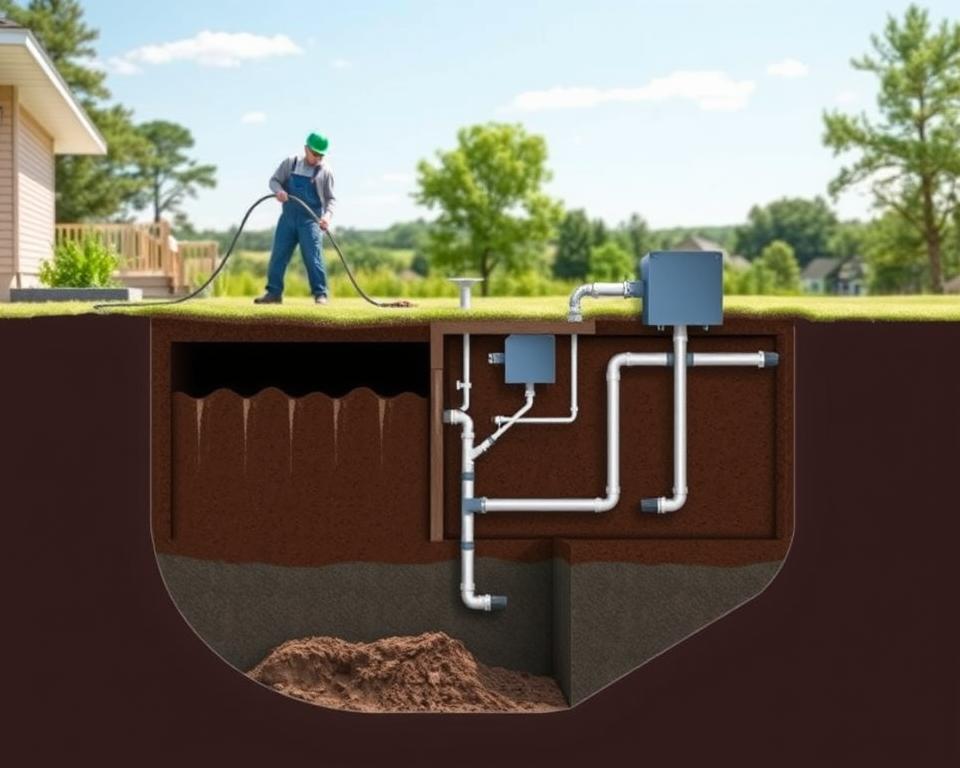Septic Cleaning Services: Protect Your Home
Do you fully understand the dangers of overlooking your septic system? For many, septic systems are crucial yet enigmatic components of their homes, often overlooked. With September 2024, comprehending the significance of septic cleaning services is vital. These services ensure your home and investment remain protected, boosting your septic system’s efficiency and defending against costly damages and environmental risks.
All in Sanitation delivers specialized septic cleaning solutions, customized to meet your unique needs. Alongside making certain your septic system operates flawlessly, we aim to preserve its condition for years to come using septic tank pumping near me.
Core Lessons
- Routine septic cleaning services are crucial for maintaining a healthy septic system.
- Prompt septic tank pumping can head off expensive repairs and secure your home’s value.
- Disregarding your septic system can lead to environmental hazards.
- Understanding septic system maintenance improves the longevity of your system.
- All in Sanitation provides bespoke services for effective septic care.
Understanding Septic Systems
A septic system is pivotal in handling wastewater for homes and businesses. It comprises a septic tank and a drain field, both integral for its operation. Understanding how these elements work is important for their effective upkeep.
The septic tank, situated underground, treats wastewater by separating it into three layers: sludge, scum, and effluent. Sludge settles to the bottom, scum floats on top, and effluent, the treated water, travels to the drain field.
In the drain field, effluent gets further cleansing. Soil there functions as a filter, neutralizing pathogens and allowing safe water drainage. Grasping the roles of the septic tank and drain field underscores the need for routine checks to ward off system breakdowns.
The Value of Septic Cleaning Services
Septic cleaning services are crucial for keeping a healthy property with a septic system. They avert solids build-up, preventing clogs and environmental hazards. By delivering regular cleaning, these services help the system run smoothly, sidestepping hefty repairs and health risks from malfunctioning systems.
Regular maintenance is key for a septic system’s longevity. It results in smoother operations and extends the components’ lifespan. Homeowners who opt for professional services lower the risk of sudden failures and unexpected expenses.
Selecting the right septic services is key. Look for skilled technicians who can ensure optimal functioning with thorough inspections. Routine maintenance secures your property and creates a cleaner living space.
Signs Your Septic System Needs Attention
It’s important to identify when your septic system is signaling for help. Homeowners must look for signs that suggest their septic system needs expert attention.
Watch out for:
- Delayed drains throughout the home
- Gurgling sounds emanating from pipes
- Bad odors hovering near the tank area
- Pooling water across the drain field
Responding quickly on these warnings can prevent severe issues. Periodic checks are vital. They help catch and resolve hidden problems early, providing everyone’s safety and health.

The Septic Pumping Process
It’s critical to comprehend the septic pumping process to keep your septic system healthy. This process mainly targets sludge removal—getting rid of the waste that has accumulated in the septic tank. Over time, the gathering of solids and scum can create blockages, adding pressure in the tank and potentially causing issues.
Experienced technicians perform a variety of tasks during the service. Besides sludge removal, they inspect the tank for any cracks or corrosion. Regular checks are necessary to avoid expensive repairs and ensure smooth system operation.
When to Schedule Septic Tank Pumping
The ideal schedule for septic tank pumping is vital for a efficient system. The recommended frequency is determined by your household size, water usage, and how much solid waste you produce. Generally, it’s recommended to pump your septic tank every one to three years for most homes.
Houses with higher waste levels, such as those using garbage disposals, may demand more frequent service. Yearly pumping is often necessary to keep these systems working efficiently. It’s important to follow expert advice to set a proper maintenance schedule.
Consistent upkeep is critical to avoid costly fixes and enhance your system’s longevity. Make sure to have scheduled checks by professionals who can evaluate your system and recommend on the most fitting pumping timetable for you.
Best Practices for Septic Maintenance
Caring for a septic system is vital for its efficiency and longevity. Effective practices can significantly boost its performance. To start, conserve water by fixing leaks in pipes and faucets. Simple actions such as turning off the faucet while brushing your teeth can conserve a lot of water.
Avoid flushing fats, oils, and grease down the sink. These can clog pipes and hamper the septic system’s function. Instead, discard them in a sealed container. Schedule regular inspections and pump-outs into your maintenance routine to aid extending the life of your system.
It’s important to shield your leach field as well. Keep vehicles or heavy equipment off it to avoid soil compaction, which impairs drainage. Using eco-friendly cleaning products assists preserve the tank’s bacterial balance, allowing the effective breakdown of waste.
| Septic System Maintenance Practices |
Benefits |
| Fix Leaks |
Reduces water usage and prevents overloading the system |
| Avoid Fats and Oils Disposal |
Keeps pipes clear and prevents clogs |
| Schedule Regular Inspections |
Identify issues early, avoiding costly repairs |
| Maintain Leach Field Health |
Ensures proper drainage and system efficiency |
| Use Eco-Friendly Products |
Preserves beneficial bacteria in the tank |
Advantages of Professional Septic Care
Homeowners gain significant advantages by investing in professional septic services. These services offer personalized maintenance plans, unique to individual systems. Inspections conducted by these specialists can spot issues early, sidestepping them from becoming severe.
Professional septic services are always equipped to provide immediate help during emergencies. Companies like All in Sanitation respond quickly, ensuring minimal disruption to daily activities. This proactive approach extends the life of septic systems and safeguards the environment.
Moreover, trained technicians have access to state-of-the-art tools and possess the expertise to address challenging challenges. Counting on professionals for septic care guarantees adherence to industry standards, sidesteps common mistakes, and enhances system efficiency.
Septic Cleaning: Residential and Commercial Differences
Septic systems are essential for hygiene in residential and commercial areas, yet each property type has unique cleaning needs that impact service strategies.
Residential septic systems handle fewer people, leading to reduced waste. This basic setup allows for simpler maintenance. Homeowners should arrange cleanings to avoid clogs and prolong their tanks’ longevity.
Commercial entities face greater waste challenges, needing more intricate systems. These have higher capacities and need comprehensive inspections. Skipping maintenance can cause costly repairs, which is why professional help is vital.
| Feature |
Residential Septic Cleaning |
Commercial Septic Cleaning |
| System Complexity |
Less complex |
More complex |
| Tank Size |
Smaller capacity |
Larger capacity |
| Frequency of Service |
Every 1-3 years |
Regularly, depending on usage |
| Inspection Requirements |
Basic inspections |
Rigorous inspections |
| Regulations |
Standard local codes |
Specialized regulations |
Risks of Ignoring Septic Maintenance
Overlooking your septic system can unleash a slew of severe and pricey issues. Homeowners who skip maintenance may experience backups, leading to sewage leaks that damage property and contaminate the environment. These malfunctions introduce risks to health and safety, far beyond mere inconvenience.
The threat to groundwater from neglected septic tanks is serious. Overflowing tanks let untreated waste enter nearby water bodies, jeopardizing wildlife and human drinking sources. Routine inspections and timely pumping are essential to avert such hazards and maintain system efficiency.
Ignoring septic system care brings hefty costs too. Lack of maintenance can demand high-priced repairs, including complete system replacement. Homeowners might confront substantial costs and disruptions unexpectedly.
| Issue |
Description |
Potential Cost |
| Backup |
Accumulation of waste in the pipes leading to overflow |
$2,000 – $7,000 |
| Sewage Leaks |
Spills of untreated wastewater, contaminating the yard |
$1,500 – $5,000 |
| Groundwater Contamination |
Pollution of local water sources from leaked waste |
$10,000+ |
| System Replacement |
Complete replacement of a faulty septic system |
$3,000 – $15,000 |
Spending on upkeep safeguards your septic system and dodges hefty fixes. Forward-thinking homeowners maintain a safe living space.
Tips for Hiring a Septic Company
Picking the right septic service company is vital for your system’s health. It’s essential to consider their licensing, experience, and customer feedback. Companies that are reliable often boost the performance and lifespan of your septic system.
All in Sanitation shines for its professionalism and commitment. They emphasize customer satisfaction, delivering expert care tailored to individual needs. They provide thorough services, including inspections and maintenance, avoiding future problems.
When hiring a septic service, keep these tips in mind:
- Check for proper licensing and certifications.
- Read online reviews and testimonials to measure customer experiences.
- Ask about the range of services offered to verify they meet your requirements.
- Inquire about the experience level of their technicians.
- Request quotes to compare pricing and service details.
By weighing these factors, homeowners can reach an informed choice and choose a septic service that fits their system’s particular needs.
Understanding Septic Cleaning Costs
The cost of septic cleaning services varies widely due to several factors. The size of the system, the frequency of pumping, and any extra required services significantly impact the price. Larger or more complicated systems typically incur greater costs.
Homeowners should prioritize setting funds aside for maintenance. Regular service not only prolongs the septic system’s life but also helps prevent costly repairs later. Prices for these services range across regions and providers, often ranging from $250 to $800 for standard pumping tasks.
To better gauge septic cleaning expenses, obtaining multiple quotes is advisable. This approach enables a well-rounded decision-making process. It’s prudent to balance the long-term benefits against the immediate costs, as regular maintenance can reduce system failures and inconvenience.
Allocating time for thorough maintenance budgeting can yield sizable financial savings over the years, reducing the likelihood of sudden, pricey repairs due to neglect. A forward-looking approach secures the efficient operation of your system, safeguarding your property’s integrity and value.
The Final Word
Understanding septic cleaning benefits is vital for homeowners with septic systems. Regular maintenance, including professional inspections and pumping, protects your residence and supports system longevity. Letting these tasks slide can cause severe issues, emphasizing the importance of effective care.
Forward-thinking cleaning and management can stop hefty repairs, maintaining smooth system operation. Selecting a reputable service provider means your septic needs are handled expertly, bringing you peace of mind.
Let All in Sanitation ease your septic system worries. Our dedicated team is here to assist your every need. Concentrate on what matters while we make sure your septic system is maintained efficiently.




